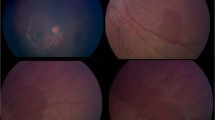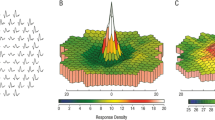Abstract
We report a case of acquired night blindness in a developed country (Spain) without risk factors for nutritional deficiency disease or family history of hereditary retinal disease. A 76-year-old woman presented with acquired night blindness of 6-month progression. After a thorough inquiry about eating patterns she becomes suspicious of vitamin A low dietary intake, which is analytically confirmed and successfully treated. Despite being very uncommon in our environment and even more in patients without digestive problems, in a patient reporting acquired night blindness vitamin A deficiency should not be discarded until eating patterns have been investigated. It might be especially relevant in certain socioeconomic situations and eating disorders such as bulimia or anorexia nervosa.
This is a preview of subscription content, access via your institution
Access options
Subscribe to this journal
Receive 12 print issues and online access
$259.00 per year
only $21.58 per issue
Buy this article
- Purchase on Springer Link
- Instant access to full article PDF
Prices may be subject to local taxes which are calculated during checkout


Similar content being viewed by others
References
Sommer A . Mortality associated with mild, untreated xerophthalmia. Trans Am Ophthalmol Soc 1983; 81: 825–8253.
Underwood BA . Vitamin A deficiency disorders: international efforts to control a preventable ‘Pox’. J Nutr 2004; 134: 231 S–236 S.
Da Rocha Lima B, Pichi F, Lowder CY . Night blindness and Chron’s disease. Int Ophthalmol 2014; 34: 1141–1144.
Fok JS, Li JY, Yong TY . Visual deterioration caused by vitamin A deficiency in patients after bariatric surgery. Eat Weight Disord 2012; 17: e144–e146.
Elison JR, Friedman AH, Brodie SE . Acquired subretinal flecks secondary to hypovitaminosis A in a patient with hepatitis C. Doc Ophthalmol 2004; 109: 279–281.
Roncone DP . Xerophtalmia secondary to alcohol-induced malnutrition. Optometry 2006; 77: 124–133.
Marmor MF, Fulton AB, Holder GE, Miyake Y, Brigell M, Bach M et al. ISCEV standard for full-field clinical electroretinography (2008 update). Doc Ophthalmol 2009; 118: 69–77.
Papathanasiou ES, Papacostas SS . Flash electroretinography: normative values with surface skin electrodes and no pupil dilation using a standard stimulation protocol. Doc Ophthalmol 2008; 116: 61–73.
Petzold A, Plant GT . Clinical disorders affecting mesopic vision. Ophthalmol Physiol Opt 2006; 26: 326–341.
Murube J, Murube E, Mompeán B . Why should the terms ‘nyctalopia’ and ‘hemeralopia’ be avoided? Arch Soc Esp Oftalmol 2002; 77: 227–228.
Wald G . The chemistry of rod vision. Science 1951; 113: 287–291.
Lengyel D, Török B . Acquired temporary night blindness in vitamin A and zinc deficiency in anorexia nervosa nine years after kidney transplantation. Klin Monbl Augenheilkd 2006; 223: 453–455.
Author information
Authors and Affiliations
Corresponding author
Ethics declarations
Competing interests
The authors declare no conflict of interests.
Rights and permissions
About this article
Cite this article
Parafita-Fernández, A., Escalona-Fermín, M., Sampil, M. et al. Acquired night blindness due to bad eating patterns. Eur J Clin Nutr 69, 752–754 (2015). https://doi.org/10.1038/ejcn.2015.35
Received:
Revised:
Accepted:
Published:
Issue Date:
DOI: https://doi.org/10.1038/ejcn.2015.35



